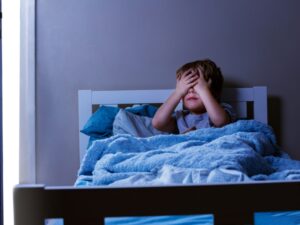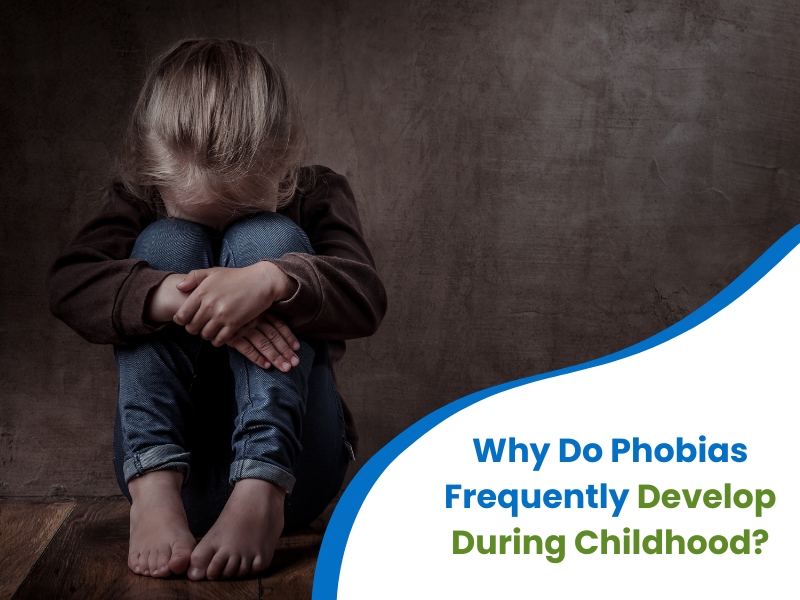Phobias are intense, irrational fears of specific objects, situations, or activities that can significantly impact daily life. While these fears are common in childhood, they often cause distress and anxiety that can extend into adulthood. Understanding why phobias develop in childhood is essential to addressing and managing them effectively. This article explores the reasons behind the development of phobias in childhood and how they can be managed.
What are phobias, and how do they affect children?
Phobias are more than just common fears; they are persistent and excessive reactions to a specific stimulus. In children, phobias can manifest in various ways, such as fear of animals, heights, or even certain sounds or situations. These fears can result in behavioural changes like avoidance, crying, or tantrums. If not addressed, these phobias may interfere with the child’s ability to function in school, social settings, and everyday activities.
Phobias in children often arise during the early stages of development, and their intensity may vary. While some children may naturally outgrow specific fears, others may experience them into adulthood if left unaddressed. Understanding the root causes of childhood phobias is crucial for helping children overcome their fears in a healthy and supportive way.
How do childhood experiences contribute to developing phobias?
Children’s experiences significantly shape their emotional responses to the world. Certain experiences, especially during critical developmental periods, can increase the risk of developing phobias. Contributing factors include:
- Traumatic events: Exposure to traumatic incidents, such as being bitten by a dog or being involved in an accident, can trigger phobias.
- Negative reinforcement: Overprotective parenting or repeated exposure to fearful situations can make phobias more intense.
- Parental influence: Children often mirror their parents’ emotional responses, adopting similar fears if a parent experiences anxiety or phobias.
- Lack of coping skills: Without learning healthy coping mechanisms, children may develop phobias to avoid uncomfortable situations.
Are there specific triggers that lead to phobias in childhood?
Phobias in children can arise from various triggers, often rooted in personal experiences, inherited tendencies, or societal influences. Common triggers include:
- Traumatic incidents: A bad experience with a specific object or situation (e.g., a traumatic visit to the dentist leading to a fear of doctors).
- Loss of control: Phobias may develop in situations where a child feels helpless or overwhelmed, such as in a crowded place.
- Parental anxiety: Children with parents who experience anxiety or mental health challenges may be more prone to developing phobias.
- Bullying or teasing: Children bullied or teased about their fears may develop lasting phobias related to those situations.
- Environmental factors: A chaotic or noisy home environment can increase anxiety, making children more susceptible to phobias.

Can childhood phobias be linked to genetic factors?
Research indicates that genetics may influence the development of phobias. Children with a family history of anxiety disorders or phobias are more likely to develop similar fears, suggesting a genetic vulnerability to anxiety.
- Family history: Children with a family history of anxiety or phobias may be more likely to experience similar issues.
- Inherited temperament: Some children may have a naturally anxious temperament that makes them more vulnerable to developing phobias.
- Brain chemistry: Research suggests that imbalances in brain chemicals, such as serotonin, may contribute to the development of anxiety and phobias.
How does the environment influence the development of phobias in children?
A child’s environment plays a crucial role in shaping how they perceive and respond to the world. Certain environmental factors can either trigger phobias or assist in managing them. These include:
- Family dynamics: Children in fear-driven environments or those who witness fearful responses may develop similar phobias.
- Social experiences: Bullying, social rejection, or negative peer interactions can lead to social phobias.
- Cultural influences: Cultural norms and taboos can shape a child’s fears, especially if certain phobias are emphasised or discouraged within the culture.
What are the signs that a child may have a phobia?
Recognising the signs of a phobia early on is essential for providing support and intervention. Common signs that a child may be struggling with a phobia include:
- Extreme avoidance: Avoiding specific situations, places, or people related to the feared object.
- Physical symptoms: Complaints of headaches, stomachaches, or other physical discomforts when faced with the feared object or situation.
- Emotional distress: Excessive crying, tantrums, or feelings of terror when exposed to the trigger.
- Difficulty in social settings: Struggling to participate in social activities or engage with peers due to fear.
- Sleep disturbances: Having trouble sleeping, primarily if nightmares or night terrors are related to the phobia.

How can families support children with phobias to overcome their fears?
Families play a crucial role in helping children overcome their fears by providing a supportive environment. Here are ways families can support children with phobias:
- Validation and empathy: Acknowledge the child’s fear without belittling it, showing understanding to help the child feel safe.
- Gradual exposure: Slowly introduce the child to the feared object or situation in a controlled, positive manner to desensitise them.
- Encouraging coping strategies: Teach relaxation techniques like deep breathing or visualisation to manage anxiety effectively.
- Seeking professional help: If the phobia persists or significantly impacts the child’s daily life, consider consulting an expert psychologist who specialises in childhood phobias.
- Teach coping mechanisms: Help your child develop healthy coping strategies, such as deep breathing, relaxation techniques, or positive self-talk.
What role does cognitive behaviour therapy play in treating childhood phobias?
Cognitive Behaviour Therapy (CBT) effectively treats childhood phobias by helping children challenge irrational thoughts. With a trained therapist, children develop healthier coping strategies and gradually face their fears in a structured, safe environment, promoting lasting change and confidence.
- Exposure therapy: Gradually exposing the child to the feared object or situation, allowing them to gain control over their reactions.
- Cognitive restructuring: Helping children manage negative thought patterns associated with their fears.
- Building confidence: Encouraging children to recognise their strengths and empowering them to face their fears.
Helping children overcome phobias
Childhood phobias are not uncommon, and with the proper support, they can be managed or even overcome. Understanding the underlying causes, recognising the signs, and offering appropriate interventions can help children lead fulfilling, fear-free lives. Families, caregivers, and healthcare professionals play a critical role in guiding children through their fears.
At Auburn Health Centre, we provide NDIS therapeutic support services that include speech therapy, psychology, occupational therapy, counselling, and behaviour support. Our compassionate and personalised approach aims to help children and families manage phobias and other challenges, ensuring a positive and supportive environment for growth. Contact Auburn Health Centre today to learn more about how we can assist your child in overcoming their fears and achieving their full potential.


